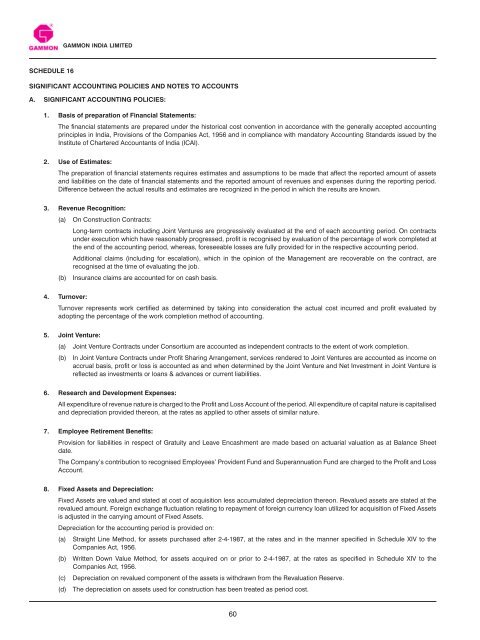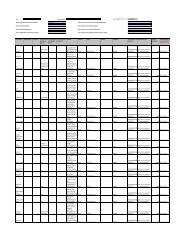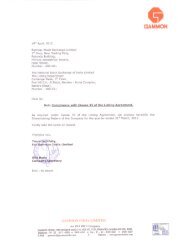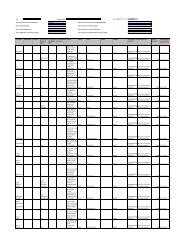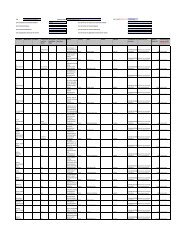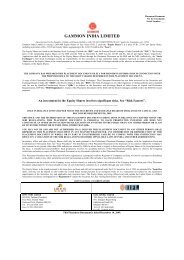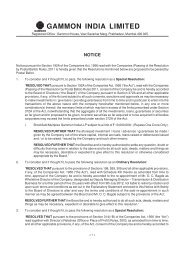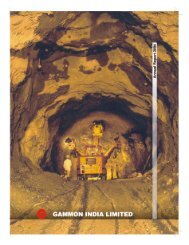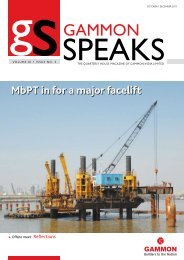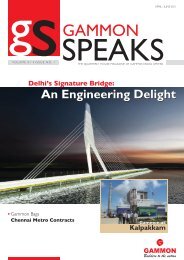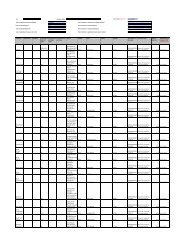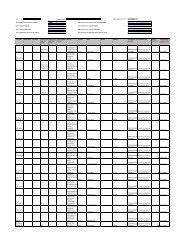Annual Report 2006-2007 - Gammon India
Annual Report 2006-2007 - Gammon India
Annual Report 2006-2007 - Gammon India
You also want an ePaper? Increase the reach of your titles
YUMPU automatically turns print PDFs into web optimized ePapers that Google loves.
SCHEDULE 16<br />
GAMMON INDIA LIMITED<br />
SIGNIFICANT ACCOUNTING POLICIES AND NOTES TO ACCOUNTS<br />
A. SIGNIFICANT ACCOUNTING POLICIES:<br />
1. Basis of preparation of Financial Statements:<br />
The financial statements are prepared under the historical cost convention in accordance with the generally accepted accounting<br />
principles in <strong>India</strong>, Provisions of the Companies Act, 1956 and in compliance with mandatory Accounting Standards issued by the<br />
Institute of Chartered Accountants of <strong>India</strong> (ICAI).<br />
2. Use of Estimates:<br />
The preparation of financial statements requires estimates and assumptions to be made that affect the reported amount of assets<br />
and liabilities on the date of financial statements and the reported amount of revenues and expenses during the reporting period.<br />
Difference between the actual results and estimates are recognized in the period in which the results are known.<br />
3. Revenue Recognition:<br />
(a) On Construction Contracts:<br />
Long-term contracts including Joint Ventures are progressively evaluated at the end of each accounting period. On contracts<br />
under execution which have reasonably progressed, profit is recognised by evaluation of the percentage of work completed at<br />
the end of the accounting period, whereas, foreseeable losses are fully provided for in the respective accounting period.<br />
Additional claims (including for escalation), which in the opinion of the Management are recoverable on the contract, are<br />
recognised at the time of evaluating the job.<br />
(b) Insurance claims are accounted for on cash basis.<br />
4. Turnover:<br />
Turnover represents work certified as determined by taking into consideration the actual cost incurred and profit evaluated by<br />
adopting the percentage of the work completion method of accounting.<br />
5. Joint Venture:<br />
(a) Joint Venture Contracts under Consortium are accounted as independent contracts to the extent of work completion.<br />
(b) In Joint Venture Contracts under Profit Sharing Arrangement, services rendered to Joint Ventures are accounted as income on<br />
accrual basis, profit or loss is accounted as and when determined by the Joint Venture and Net Investment in Joint Venture is<br />
reflected as investments or loans & advances or current liabilities.<br />
6. Research and Development Expenses:<br />
All expenditure of revenue nature is charged to the Profit and Loss Account of the period. All expenditure of capital nature is capitalised<br />
and depreciation provided thereon, at the rates as applied to other assets of similar nature.<br />
7. Employee Retirement Benefits:<br />
Provision for liabilities in respect of Gratuity and Leave Encashment are made based on actuarial valuation as at Balance Sheet<br />
date.<br />
The Company’s contribution to recognised Employees’ Provident Fund and Superannuation Fund are charged to the Profit and Loss<br />
Account.<br />
8. Fixed Assets and Depreciation:<br />
Fixed Assets are valued and stated at cost of acquisition less accumulated depreciation thereon. Revalued assets are stated at the<br />
revalued amount. Foreign exchange fluctuation relating to repayment of foreign currency loan utilized for acquisition of Fixed Assets<br />
is adjusted in the carrying amount of Fixed Assets.<br />
Depreciation for the accounting period is provided on:<br />
(a) Straight Line Method, for assets purchased after 2-4-1987, at the rates and in the manner specified in Schedule XIV to the<br />
Companies Act, 1956.<br />
(b) Written Down Value Method, for assets acquired on or prior to 2-4-1987, at the rates as specified in Schedule XIV to the<br />
Companies Act, 1956.<br />
(c) Depreciation on revalued component of the assets is withdrawn from the Revaluation Reserve.<br />
(d) The depreciation on assets used for construction has been treated as period cost.<br />
60


